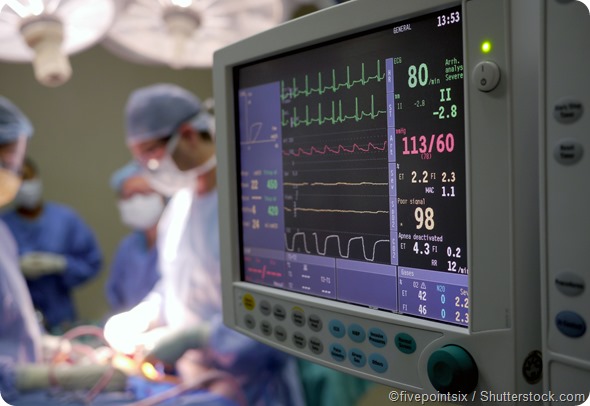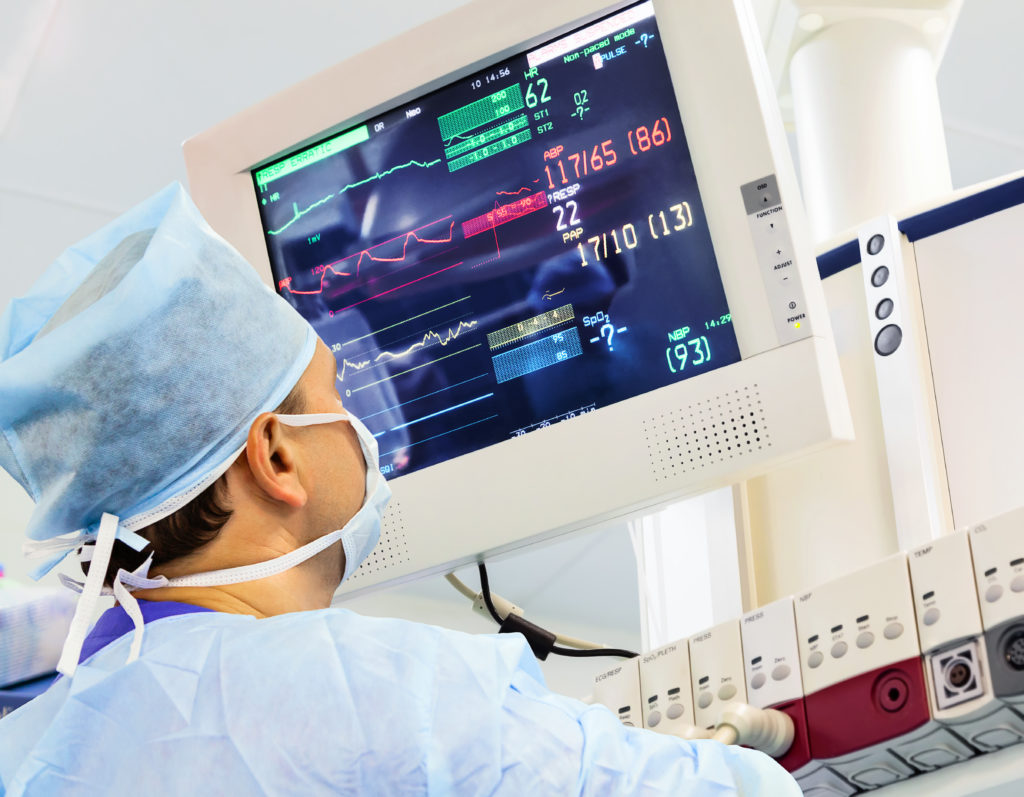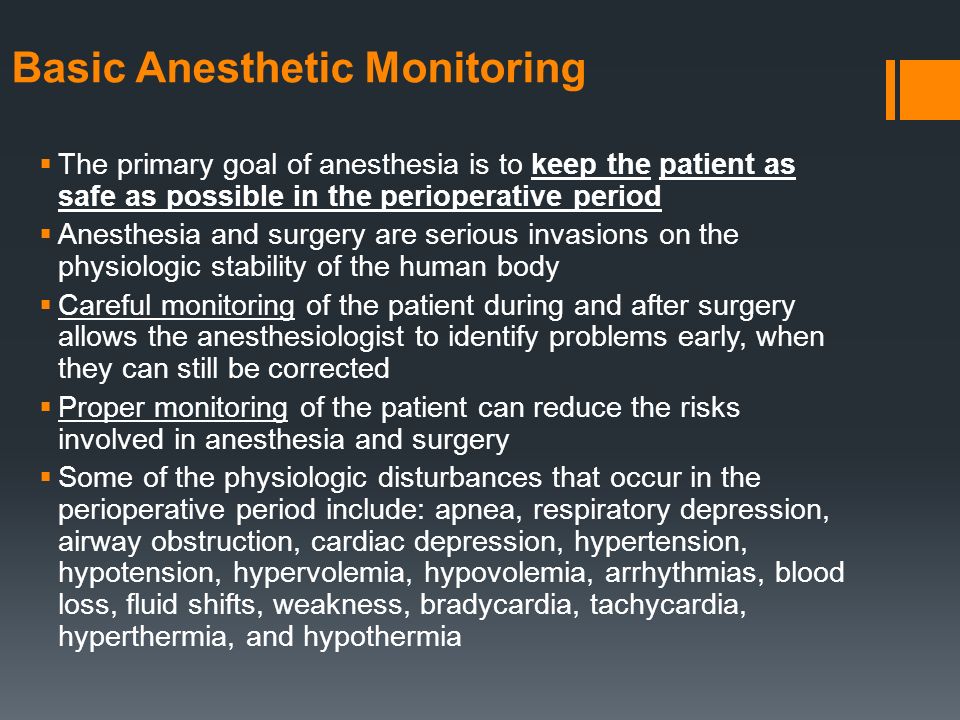Your What should you monitor during anesthesia images are available. What should you monitor during anesthesia are a topic that is being searched for and liked by netizens now. You can Download the What should you monitor during anesthesia files here. Get all royalty-free photos and vectors.
If you’re looking for what should you monitor during anesthesia pictures information linked to the what should you monitor during anesthesia topic, you have visit the right blog. Our site always gives you hints for viewing the maximum quality video and image content, please kindly surf and find more informative video content and graphics that fit your interests.
What Should You Monitor During Anesthesia. Start studying Monitoring During Anesthesia. The anesthetist should be comfortable with hands-on monitoring using ones own senses sight sound touch in determining patients respiratory status. Neuromonitoring is a technology that allows the surgeon to assess spinal cord function during surgery through real-time feedback from individual nerve roots motor tracts and sensory tracts. After the introduction of the first commercial intraoperative neuromonitoring IONM the procedure became popular in the 1980s.
 Intraoperative Monitoring Iom From news-medical.net
Intraoperative Monitoring Iom From news-medical.net
An inflatable blood pressure cuff. We conclude that 1 the activated clotting time ACT is an accurate method of monitoring anti-coagulation during peripheral vascular surgery and can easily be performed by a technician in the operating room or at the bedside. Monitored Anesthesia Care MAC also known as conscious sedation or twilight sleep is a type of sedation that is administered through an IV to make a patient sleepy and calm during a procedure. This may develop as a reaction to anesthetic drugs or in the case of patients who are febrile before surgery. 2 an initial heparinizing dose of 120 to 130 unitskg is adequate in 95 per cent of the patients. After the introduction of the first commercial intraoperative neuromonitoring IONM the procedure became popular in the 1980s.
Temperature should be monitored at least every 15 minutes if not more frequently.
The ability to conform to these standards should be confirmed for every anesthetic. By monitoring the anesthetized patient the anesthetist obtains information in the following areas. Brain function monitors have also been called depth of anesthesia monitors. Periodic quantitative measurement of BP in humans predating the era of evidence-based medicine by over a century is a component of the American Society of Anesthesiologists standards for basic anesthetic monitoring and is a staple of anesthetic management worldwide. A combination of devices pulse oximetery SpO2 and. Standards for Basic Anesthetic Monitoring.
 Source: pinterest.com
Source: pinterest.com
2 an initial heparinizing dose of 120 to 130 unitskg is adequate in 95 per cent of the patients. Instruments commonly used for monitoring during anesthesia include. Brain function monitors have also been called depth of anesthesia monitors. Hemodynamic monitoring during anesthesia involves watching the heart rate and rhythm the blood pressure and your oxygen level. - an index of a patients cardiovascular status - the depth of anesthesia - response to therapeutic intervention - an indication for adjusting fluid therapy and - titrating drug doses.
 Source: pinterest.com
Source: pinterest.com
Palpation of a pulse auscultation of heart sounds monitoring of a tracing of intra-arterial pressure ultrasound peripheral pulse monitoring or pulse plethysmography or oximetry. Brain function monitors measures the very small waves of activity produced by the brain. They are designed to give an additional method of assessing when a patient is unconscious from anesthesia. The ability to conform to these standards should be confirmed for every anesthetic. The patient is typically awake but groggy and are able to.
 Source: pinterest.com
Source: pinterest.com
The patient is typically awake but groggy and are able to. Hemodynamic monitoring during anesthesia involves watching the heart rate and rhythm the blood pressure and your oxygen level. Closely monitor the heart rate mucous membrane color and SpO 2 for 1 to 2 minutes before assuming that a serious problem exists. - an index of a patients cardiovascular status - the depth of anesthesia - response to therapeutic intervention - an indication for adjusting fluid therapy and - titrating drug doses. A combination of devices pulse oximetery SpO2 and.
 Source: slideplayer.com
Source: slideplayer.com
This may develop as a reaction to anesthetic drugs or in the case of patients who are febrile before surgery. An inflatable blood pressure cuff. Periodic quantitative measurement of BP in humans predating the era of evidence-based medicine by over a century is a component of the American Society of Anesthesiologists standards for basic anesthetic monitoring and is a staple of anesthetic management worldwide. This is usually strapped around your upper arm. The first step is to visually verify that the appropriate monitoring supplies BP cuffs oximetry probes etc are available.
 Source: asahq.org
Source: asahq.org
A combination of devices pulse oximetery SpO2 and. They are designed to give an additional method of assessing when a patient is unconscious from anesthesia. Standards for patient monitoring during anesthesia are clearly defined. All of these standards state that the most important monitor is the presence of an anesthesia clinician throughout anesthesia and include statements that a blood pressure monitor pulse oximeter and ETCO 2 monitor should. Brain function monitors have also been called depth of anesthesia monitors.
 Source: pinterest.com
Source: pinterest.com
Blood pressure pulse respiration are required measurements during all anesthetics but body temperature is not. The main functions monitored during general anesthesia include oxygenation circulation and temperature by measuring parameters such as heart pulse and rhythm blood pressure oxygen saturation and temperature level. Temperature should be monitored at least every 15 minutes if not more frequently. We conclude that 1 the activated clotting time ACT is an accurate method of monitoring anti-coagulation during peripheral vascular surgery and can easily be performed by a technician in the operating room or at the bedside. Standards for patient monitoring during anesthesia are clearly defined.
 Source: theveterinarynurse.com
Source: theveterinarynurse.com
The vitals that are typically monitored under anesthesia. These are just a few of the monitors the anesthesiologist uses to keep you safe and comfortable for. ANIMAL BLOOD PRESSURE MONITORING DURING SURGERY Assess anesthetic depth Monitor trends to provide. Hemodynamic monitoring during anesthesia involves watching the heart rate and rhythm the blood pressure and your oxygen level. Periodic quantitative measurement of BP in humans predating the era of evidence-based medicine by over a century is a component of the American Society of Anesthesiologists standards for basic anesthetic monitoring and is a staple of anesthetic management worldwide.
 Source: pinterest.com
Source: pinterest.com
All of these standards state that the most important monitor is the presence of an anesthesia clinician throughout anesthesia and include statements that a blood pressure monitor pulse oximeter and ETCO 2 monitor should. Standards for patient monitoring during anesthesia are clearly defined. Heart rate is defined as the number of heartbeats per unit time expressed as beats per minute. Monitor adequacy of circulation. The ability to conform to these standards should be confirmed for every anesthetic.
 Source: pinterest.com
Source: pinterest.com
Palpation of a pulse auscultation of heart sounds monitoring of a tracing of intra-arterial pressure ultrasound peripheral pulse monitoring or pulse plethysmography or oximetry. Breathing volume rate and pressure are monitored by clinical observation from an anesthesia team member. This may develop as a reaction to anesthetic drugs or in the case of patients who are febrile before surgery. An electrocardiogram EKG. The surgical team will bring you to a recovery room after your procedure where your nurse will monitor your vitals and give you any medication prescribed by your doctor.
 Source: slideplayer.com
Source: slideplayer.com
Instruments commonly used for monitoring during anesthesia include. Periodic quantitative measurement of BP in humans predating the era of evidence-based medicine by over a century is a component of the American Society of Anesthesiologists standards for basic anesthetic monitoring and is a staple of anesthetic management worldwide. An inflatable blood pressure cuff. This is usually strapped around your upper arm. The ability to conform to these standards should be confirmed for every anesthetic.
 Source: pinterest.com
Source: pinterest.com
The vitals that are typically monitored under anesthesia. Periodic quantitative measurement of BP in humans predating the era of evidence-based medicine by over a century is a component of the American Society of Anesthesiologists standards for basic anesthetic monitoring and is a staple of anesthetic management worldwide. All of these standards state that the most important monitor is the presence of an anesthesia clinician throughout anesthesia and include statements that a blood pressure monitor pulse oximeter and ETCO 2 monitor should. Learn vocabulary terms and more with flashcards games and other study tools. Not so during anesthesia.
 Source: pinterest.com
Source: pinterest.com
Breathing volume rate and pressure are monitored by clinical observation from an anesthesia team member. Brain function monitors measures the very small waves of activity produced by the brain. Instruments commonly used for monitoring during anesthesia include. The surgical team will bring you to a recovery room after your procedure where your nurse will monitor your vitals and give you any medication prescribed by your doctor. ANIMAL BLOOD PRESSURE MONITORING DURING SURGERY Assess anesthetic depth Monitor trends to provide.
 Source: researchgate.net
Source: researchgate.net
This may develop as a reaction to anesthetic drugs or in the case of patients who are febrile before surgery. While less common hyperthermia may also be observed. All monitors should be turned on and proper completion of power. We conclude that 1 the activated clotting time ACT is an accurate method of monitoring anti-coagulation during peripheral vascular surgery and can easily be performed by a technician in the operating room or at the bedside. The vitals that are typically monitored under anesthesia.
 Source: pinterest.com
Source: pinterest.com
Periodic quantitative measurement of BP in humans predating the era of evidence-based medicine by over a century is a component of the American Society of Anesthesiologists standards for basic anesthetic monitoring and is a staple of anesthetic management worldwide. 3 the ACT should be maintained at greater than twice. Periodic quantitative measurement of BP in humans predating the era of evidence-based medicine by over a century is a component of the American Society of Anesthesiologists standards for basic anesthetic monitoring and is a staple of anesthetic management worldwide. Every patient receiving general anesthesia shall have in addition to the above circulatory function continually evaluated by at least one of the following. - an index of a patients cardiovascular status - the depth of anesthesia - response to therapeutic intervention - an indication for adjusting fluid therapy and - titrating drug doses.
 Source: id.pinterest.com
Source: id.pinterest.com
True respiratory arrest may result from anesthetic overdose lack of oxygen flow or. Blood pressure pulse respiration are required measurements during all anesthetics but body temperature is not. For example the American Society of Anesthesiologists guideline on temperature measurement during anesthesia is somewhat vague. The anesthetist should be comfortable with hands-on monitoring using ones own senses sight sound touch in determining patients respiratory status. True respiratory arrest may result from anesthetic overdose lack of oxygen flow or.
 Source: pinterest.com
Source: pinterest.com
The ability to conform to these standards should be confirmed for every anesthetic. The anesthetist should be comfortable with hands-on monitoring using ones own senses sight sound touch in determining patients respiratory status. The first step is to visually verify that the appropriate monitoring supplies BP cuffs oximetry probes etc are available. For example the American Society of Anesthesiologists guideline on temperature measurement during anesthesia is somewhat vague. Standards for Basic Anesthetic Monitoring.
 Source: slideplayer.com
Source: slideplayer.com
An inflatable blood pressure cuff. Monitored Anesthesia Care MAC also known as conscious sedation or twilight sleep is a type of sedation that is administered through an IV to make a patient sleepy and calm during a procedure. This may develop as a reaction to anesthetic drugs or in the case of patients who are febrile before surgery. Neuromonitoring is a technology that allows the surgeon to assess spinal cord function during surgery through real-time feedback from individual nerve roots motor tracts and sensory tracts. Heart rate is defined as the number of heartbeats per unit time expressed as beats per minute.
 Source: news-medical.net
Source: news-medical.net
For example the American Society of Anesthesiologists guideline on temperature measurement during anesthesia is somewhat vague. Anesthesia monitoring cheat sheet. The main functions monitored during general anesthesia include oxygenation circulation and temperature by measuring parameters such as heart pulse and rhythm blood pressure oxygen saturation and temperature level. Mechanical monitoring by the anesthetist involves the use of equipment that will aide in assessing the patients ventilation. A pulse oximeter a small instrument that is attached to your finger toe or earlobe to measure the level of oxygen in.
This site is an open community for users to submit their favorite wallpapers on the internet, all images or pictures in this website are for personal wallpaper use only, it is stricly prohibited to use this wallpaper for commercial purposes, if you are the author and find this image is shared without your permission, please kindly raise a DMCA report to Us.
If you find this site beneficial, please support us by sharing this posts to your favorite social media accounts like Facebook, Instagram and so on or you can also bookmark this blog page with the title what should you monitor during anesthesia by using Ctrl + D for devices a laptop with a Windows operating system or Command + D for laptops with an Apple operating system. If you use a smartphone, you can also use the drawer menu of the browser you are using. Whether it’s a Windows, Mac, iOS or Android operating system, you will still be able to bookmark this website.






